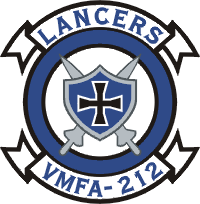
Marine Fighter Attack Squadron 212 (VMFA-212) was a United States Marine Corps F/A-18 Hornet squadron. Most recently known as the "Lancers", the squadron was last based at Marine Corps Air Station Iwakuni, Japan and fell under the command of Marine Aircraft Group 12 (MAG-12) and the 1st Marine Aircraft Wing. VMFA-212 has an extensive combat history having participated in combat operations during World War II, the Korean War, Vietnam War, the Gulf War, and Operation Enduring Freedom. Due to a re-organization within Marine aviation, the squadron was deactivated in 2008.

Marine Fighter Attack Squadron 232 (VMFA-232) is a United States Marine Corps F/A-18 Hornet squadron. Nicknamed the "Red Devils", the squadron is based at Marine Corps Air Station Miramar, California and falls under the command of Marine Aircraft Group 11 (MAG-11) and the 3rd Marine Aircraft Wing. The Red Devils are the oldest and most decorated fighter squadron in the Marine Corps.
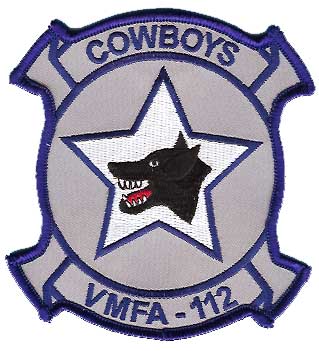
Marine Fighter Attack Squadron 112 (VMFA-112) is a reserve United States Marine Corps McDonnell-Douglas F/A-18 Hornet squadron. The squadron is based at NASJRB Fort Worth, Texas and falls under the command of Marine Aircraft Group 41 (MAG-41), 4th Marine Aircraft Wing. Their tail code is MA. During World War II the squadron saw extensive action throughout the Pacific Theater of Operations especially at the Battle of Guadalcanal as part of the Cactus Air Force. By the end of the war, its 140 air-to-air kills ranked it third among Marine Corps squadrons.

Marine Fighter Attack Squadron 323 (VMFA-323) is an aircraft carrier-based aviation squadron of the United States Marine Corps. The squadron is equipped with the McDonnell Douglas F/A-18C Hornet and is based at Marine Corps Air Station Miramar, California, United States. It falls under the command of Marine Aircraft Group 11 (MAG-11) and the 3rd Marine Aircraft Wing but deploys with the U.S. Navy's Carrier Air Wing 17 (CVW-17). Their tail code is WS and their radio callsign is Snake.

Marine Fighter Attack Squadron 333 (VMFA-333) was a United States Marine Corps fighter squadron consisting of F/A-18 Hornets. Known as the "Fighting Shamrocks" and "Trip Trey", the squadron participated in action during World War II, the Vietnam War and Operation Desert Storm The squadron’s aircraft were easily recognizable by the row of three shamrocks painted on the vertical stabilizers of their aircraft. They were decommissioned on 31 March 1992.

Marine Fighter Attack Squadron 311 (VMFA-311) is a United States Marine Corps fighter attack squadron consisting of F-35C Lightning II. Known as the "Tomcats", the squadron is based at Marine Corps Air Station Miramar, California and falls under the command of Marine Aircraft Group 11 (MAG-11) and the 3rd Marine Aircraft Wing.

Marine Fighter Attack Training Squadron 502 (VMFAT-502) is a United States Marine Corps fighter attack training squadron flying the Lockheed Martin F-35 Lightning II. Known as the "Flying Nightmares", the squadron maintains the history of Marine Attack Squadron 513 (VMA-513) which dates back to World War II and was decommissioned on 12 July 2013. The squadron is based at Marine Corps Air Station Miramar and falls under the command of Marine Aircraft Group 11 and the 3rd Marine Aircraft Wing
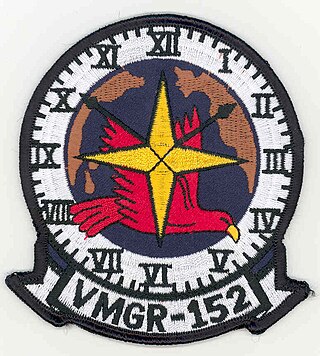
Marine Aerial Refueler Transport Squadron 152 (VMGR-152) provides aerial refueling service to support Fleet Marine Force (FMF) air operations; and provides assault air transport of personnel, equipment, and supplies. The squadron, known as the "Sumos", flies the fixed-wing Lockheed Martin KC-130J aircraft. VMGR-152 is stationed at Marine Corps Air Station Iwakuni, Iwakuni, Japan and is part of Marine Aircraft Group 12 (MAG-12) and the 1st Marine Aircraft Wing.

Marine Heavy Helicopter Squadron 464 (HMH-464) is a United States Marine Corps helicopter squadron consisting of CH-53E Super Stallion transport helicopters. The squadron is known as the "Condors" and is based at Marine Corps Air Station New River in North Carolina. They fall under the command of Marine Aircraft Group 29 (MAG-29) and the 2nd Marine Aircraft Wing.

Marine Aerial Refueler Transport Squadron 352 (VMGR-352) is a United States Marine Corps KC-130J squadron. They are a part of Marine Aircraft Group 11 (MAG-11), 3rd Marine Aircraft Wing and provide both fixed-wing and rotary-wing aerial refueling capabilities to support Fleet Marine Force (FMF) air operations in addition to assault air transport of personnel, equipment, and supplies. The squadron, known as the "Raiders" is stationed at Marine Corps Air Station Miramar, California.

Marine Heavy Helicopter Squadron 461 (HMH-461) is a United States Marine Corps helicopter squadron consisting of CH-53K King Stallion transport helicopters. The squadron, known as "Ironhorse", is based at Marine Corps Air Station New River in North Carolina and falls under the command of Marine Aircraft Group 29 (MAG-29) and the 2nd Marine Aircraft Wing. With its lineage starting in 1944, HMH-461 is the oldest active Heavy Lift Helicopter Squadron in the Marine Corps.
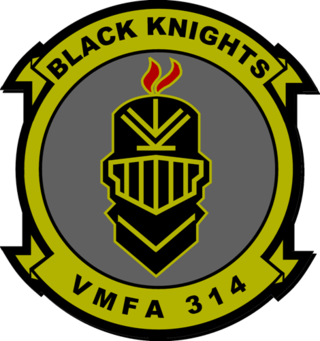
Marine Fighter Attack Squadron 314 (VMFA-314) is a United States Marine Corps F-35C Lightning II squadron. The squadron, known as the "Black Knights", is based at Marine Corps Air Station Miramar, California and falls under the command of Marine Aircraft Group 11 (MAG-11) and the 3rd Marine Aircraft Wing, but deploys with the US Navy's Carrier Air Wing Nine (NG).
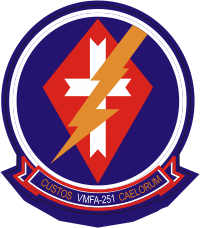
Marine Fighter Attack Squadron 251 (VMFA-251) was a United States Marine Corps F/A-18 Hornet squadron. Known as the "Thunderbolts", the squadron was deactivated on 23 April 2020. If current plans hold, the squadron is to be re-activated by 2025 as a F-35C Lightning II and based at Marine Corps Air Station Cherry Point, North Carolina.
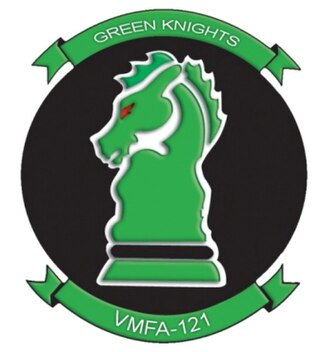
Marine Fighter Attack Squadron 121 (VMFA-121), also known as the "Green Knights", is a United States Marine Corps aircraft squadron operating the F-35B Lightning II. The squadron is based at Marine Corps Air Station Iwakuni, Japan and falls under the command of Marine Aircraft Group 12 (MAG-12) and the 1st Marine Aircraft Wing. Their tail code is VK and their radio call sign is "Combat".

Marine Fighter Attack Squadron 312 (VMFA-312) is a United States Marine Corps F/A-18C Hornet squadron. Also known as the "Checkerboards", the squadron is based at Marine Corps Air Station Beaufort, South Carolina and falls under the command of Marine Aircraft Group 31 (MAG-31) and the 2nd Marine Aircraft Wing. The Radio Callsign is "Check."

Marine Aircraft Group 41 (MAG-41) is a United States Marine Corps reserve aviation unit based at Naval Air Station Joint Reserve Base Fort Worth, Texas that is currently composed of one F/A-18C squadron, one KC-130J squadron, one C-40 squadron, two Northrop F-5 aggressor squadron based at Marine Corps Air Station Yuma, Arizona and Marine Corps Air Station Beaufort, South Carolina, one Marine Light Attack Helicopter Squadron at MCAS Camp Pendleton, one MV-22B squadron based at MCAS Miramar, one aviation logistics squadron and two wing support squadrons with multiple detachments throughout the United States.

Marine Aerial Refueler Transport Squadron 452 (VMGR-452) was a reserve United States Marine Corps cargo squadron that previously flew the Lockheed Martin KC-130J. The squadron fell under the command of Marine Aircraft Group 49 (MAG-49) and the 4th Marine Aircraft Wing. The squadron, known as the "Yankees", was stationed at Stewart Air National Guard Base, New York.

Marine Aerial Refueler Transport Squadron 252 (VMGR-252) is a United States Marine Corps KC-130J squadron. They are a part of Marine Aircraft Group 14 (MAG-14), 2nd Marine Aircraft Wing and provide both fixed-wing and rotary-wing aerial refueling capabilities to support Fleet Marine Force air operations in addition to assault air transport of personnel, equipment, and supplies. The squadron, known as "Otis" is stationed at Marine Corps Air Station Cherry Point, North Carolina. It also has the distinction of being the oldest continually active squadron in the Marine Corps.

Marine Fighter Attack Squadron 533 (VMFA-533) is a United States Marine Corps F-35B squadron. Also known as the "Hawks", the squadron is based at Marine Corps Air Station Beaufort, South Carolina and falls under the command of Marine Aircraft Group 31 (MAG-31) and the 2nd Marine Aircraft Wing.
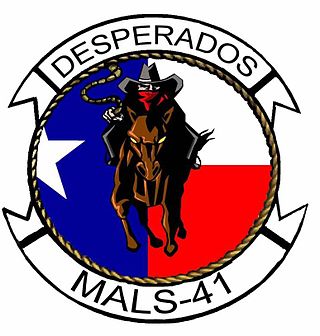
Marine Aviation Logistics Squadron 41 (MALS-41) is a reserve aviation logistics support unit of the United States Marine Corps. They fall under the command of Marine Aircraft Group 41 and 4th Marine Aircraft Wing and are currently based at Naval Air Station Joint Reserve Base Fort Worth. MALS-41 provides intermediate level maintenance support to VMFA-112 and VMGR-234 with an additional detachment in MCAS Miramar supporting VMM-764.

























